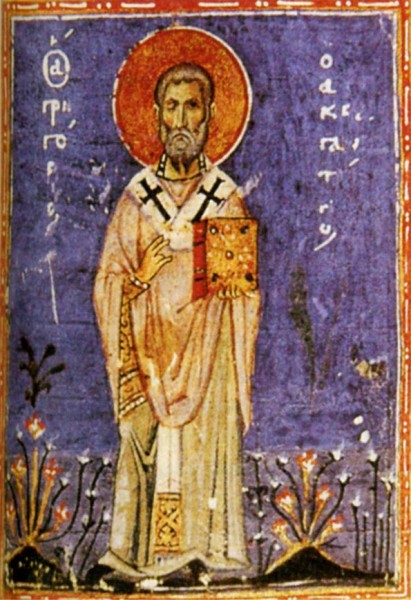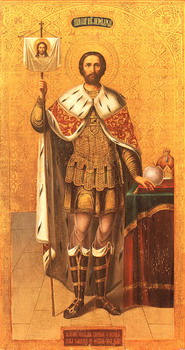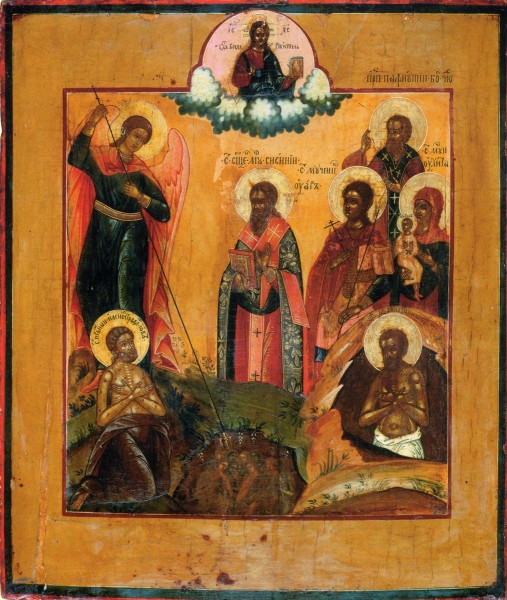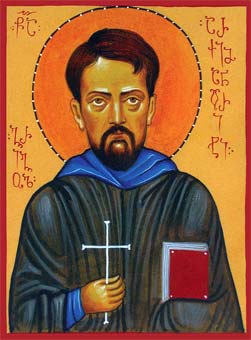|
|
St Amphilochius, Bishop of Iconium A fellow-countryman and friend of St Basil the Great and other great saints of the fourth century, Amphilochius early forsook the bustle of the world and withdrew to a cave where, as a solitary, he lived in asceticism for forty years. The episcopal throne in Iconium then fell empty, and Amphilochius was chosen in a wonderful way and consecrated as Bishop of Iconium. He was a marvellous shepherd and a great defender of the purity of the Orthodox faith, and took part in the Second Ecumenical Council in 381. He fought zealously against Macedonius, and against the Arians and the Eunomians. He personally begged Theodosius the Great to drive the Arians out of every city in the Empire, but the Emperor did not comply with his request. After a few days, Amphilochius came before the Emperor again. When the bishop was taken into the presence-chamber, the Emperor was sitting on his throne with his son Arcadius, whom he had taken as co-Emperor, sitting at his right hand. Entering the room, Amphilochius did reverence to Theodosius, but ignored Arcadius as though he were not there. Infuriated by this, the Emperor Theodosius commanded that Amphilochius be instantly driven from court. The saint then said to the Emperor: "Do you see, 0 Emperor, how you do not tolerate a slight paid to your son? In the same way, God the Father does not tolerate dishonour paid to His Son, turning with loathing from those who blaspheme against Him, and being angered at that accursed Arian heresy." Hearing this, the Emperor understood the reason for Amphilochius"s seeming disrespect towards his son, and marvelled at his wisdom and daring. Among many other works, Amphilochius wrote several books on the Faith. He entered into rest in 395 in great old age, and went to immortal life. A fellow-countryman and friend of St Basil the Great and other great saints of the fourth century, Amphilochius early forsook the bustle of the world and withdrew to a cave where, as a solitary, he lived in asceticism for forty years. The episcopal throne in Iconium then fell empty, and Amphilochius was chosen in a wonderful way and consecrated as Bishop of Iconium. He was a marvellous shepherd and a great defender of the purity of the Orthodox faith, and took part in the Second Ecumenical Council in 381. He fought zealously against Macedonius, and against the Arians and the Eunomians. He personally begged Theodosius the Great to drive the Arians out of every city in the Empire, but the Emperor did not comply with his request. After a few days, Amphilochius came before the Emperor again. When the bishop was taken into the presence-chamber, the Emperor was sitting on his throne with his son Arcadius, whom he had taken as co-Emperor, sitting at his right hand. Entering the room, Amphilochius did reverence to Theodosius, but ignored Arcadius as though he were not there. Infuriated by this, the Emperor Theodosius commanded that Amphilochius be instantly driven from court. The saint then said to the Emperor: "Do you see, 0 Emperor, how you do not tolerate a slight paid to your son? In the same way, God the Father does not tolerate dishonour paid to His Son, turning with loathing from those who blaspheme against Him, and being angered at that accursed Arian heresy." Hearing this, the Emperor understood the reason for Amphilochius"s seeming disrespect towards his son, and marvelled at his wisdom and daring. Among many other works, Amphilochius wrote several books on the Faith. He entered into rest in 395 in great old age, and went to immortal life.St Gregory, Bishop of Agrigentum He was born in Sicily, near the town of Agrigentum (where he was later bishop), of his devout parents Chariton and Theodota. His whole life was woven through with God"s wonders. He went to Jerusalem in a wonderful way, was chosen as bishop in a wonderful way and was saved from slander in a wonderful way. He himself was a great wonderworker, for he was greatly pleasing to God, and was a great spiritual guide and ascetic. He took part in the Fifth Ecumenical Council in Constantinople in 553. After severe temptations, he entered peacefully into rest at the end of the sixth century or the beginning of the seventh. He was born in Sicily, near the town of Agrigentum (where he was later bishop), of his devout parents Chariton and Theodota. His whole life was woven through with God"s wonders. He went to Jerusalem in a wonderful way, was chosen as bishop in a wonderful way and was saved from slander in a wonderful way. He himself was a great wonderworker, for he was greatly pleasing to God, and was a great spiritual guide and ascetic. He took part in the Fifth Ecumenical Council in Constantinople in 553. After severe temptations, he entered peacefully into rest at the end of the sixth century or the beginning of the seventh.St Alexander of the Neva (Nevsky) The son of Prince Yaroslav, his heart was drawn to God from his youth. He overcame the Swedes on the river Neva on July 15th, 1240, whence he took the name "of the Neva". On that occasion, Ss Boris and Gleb appeared to one of Alexander"s generals and promised their aid to the great prince, their kinsman. Among the Golden Horde of the Tartars, he refused to sacrifice to idols or pass through fire. The Tartar Khan valued him for his wisdom, and his physical strength and beauty. He built many churches, and performed innumerable works of mercy. He entered into rest at the age of forty-three, on November 14th, 1263, today being the commemoration of the translation of his relics to the city of Vladimir. The son of Prince Yaroslav, his heart was drawn to God from his youth. He overcame the Swedes on the river Neva on July 15th, 1240, whence he took the name "of the Neva". On that occasion, Ss Boris and Gleb appeared to one of Alexander"s generals and promised their aid to the great prince, their kinsman. Among the Golden Horde of the Tartars, he refused to sacrifice to idols or pass through fire. The Tartar Khan valued him for his wisdom, and his physical strength and beauty. He built many churches, and performed innumerable works of mercy. He entered into rest at the age of forty-three, on November 14th, 1263, today being the commemoration of the translation of his relics to the city of Vladimir.St Mitrophan, Bishop of Voronezh A famous Russian hierarch, ascetic and patriot, he was first a friend and then a strong critic of Peter the Great. He entered into rest on November 23rd, 1703. His wonderworking relics were discovered in 1832. A famous Russian hierarch, ascetic and patriot, he was first a friend and then a strong critic of Peter the Great. He entered into rest on November 23rd, 1703. His wonderworking relics were discovered in 1832.St. Sisinius the confessor, bishop of Cyzicus (ca. 325) The Holy Martyr Sisinias, Bishop of Kyzika, suffered for Christ during the reign of Diocletian (284-305) under the governor of Kyzika, Alexander. After many and terrible torments the martyr was beheaded. The Holy Martyr Sisinias, Bishop of Kyzika, suffered for Christ during the reign of Diocletian (284-305) under the governor of Kyzika, Alexander. After many and terrible torments the martyr was beheaded.Martyr Theodore of Antioch (4th c.)The Holy Martyr Theodore of Antioch, a fifteen year old lad, was condemned to fierce torments for confessing Christ by the emperor Julian the Apostate (361-363). The executioners were dismayed that the saint could rejoice at the time of tortures, and cease to feel the pain. They reported about this miracle to the emperor, and he gave orders to release the saint. The Martyr Theodore afterwards related, that when they were tormenting him, an Angel appeared and relieved the suffering, and after the torture the Angel left, and the saint began to feel the pain. The holy Martyr Theodore lived to old age and peacefully expired to the Lord.
St. Dionysius I, patriarch of Constantinople (15th c.)St. Helenus of Tarsus, bishop
New Martyr Archimandrite Gregory (Peradze) of Georgia (1942.) Archimandrite Gregory (Peradze) was born August 31, 1899, in the village of Bakurtsikhe, in the Sighnaghi district of Kakheti. His father, Roman Peradze, was a priest. In 1918 Gregory completed his studies at the theological school and seminary in Tbilisi and enrolled in the philosophy department at Tbilisi University. Three years later, in 1921, he began to teach at the university, but theGeorgian Church soon sent him to Germany to study theology... Archimandrite Gregory (Peradze) was born August 31, 1899, in the village of Bakurtsikhe, in the Sighnaghi district of Kakheti. His father, Roman Peradze, was a priest. In 1918 Gregory completed his studies at the theological school and seminary in Tbilisi and enrolled in the philosophy department at Tbilisi University. Three years later, in 1921, he began to teach at the university, but theGeorgian Church soon sent him to Germany to study theology... |